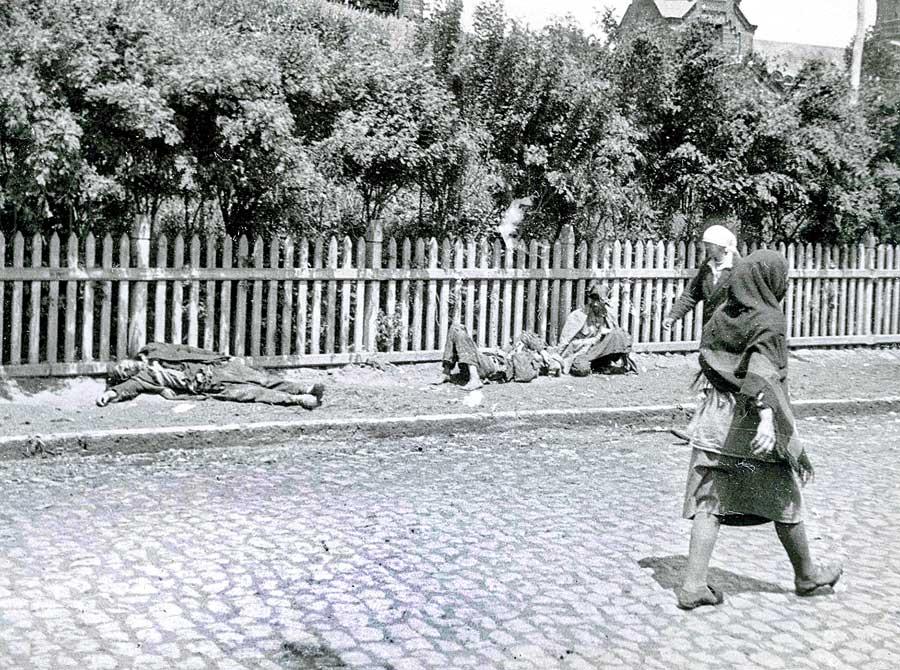Reply To:
Name - Reply Comment

The picture shows people dying of starvation on the streets of Ukraine during the Holodomor
The Russia-Ukraine war is creating uncertainty in world politics; just like every other modern warfare the usage of missiles and high-tech weapons have been the norm in this war as well. However, in the 1930s Russia (then Soviet Union) initiated an attack against Ukraine and no missiles or weapons were fired. The only weapon used was starvation.
missiles and high-tech weapons have been the norm in this war as well. However, in the 1930s Russia (then Soviet Union) initiated an attack against Ukraine and no missiles or weapons were fired. The only weapon used was starvation.
This event in history is known as ‘Holodomor’ which is made up from the Ukrainian words “Holod” (Hunger) and “Mor” (Destroy), literally translated as ‘Destroy by hunger’.
The Beginning – Collective Farming
Joseph Stalin, the leader of the Soviet Union, introduced the policy of ‘Collective Farming’ where people were forced to work together in farms irrespective of their social status. He felt that the Soviet states hadn’t been producing enough harvest and all citizens should contribute towards it.
The land owned peasants (known as Kulaks) were not in favour of collective farming as they were not keen on farming in someone else’s land by neglecting theirs. To make matters worse collective farming was a failure as it did not produce enough yield, which caused a severe crop shortage within the Soviet Union.
Apart from the production of food crops were traded to purchase equipment needed for the industries by the Soviet government, so this failure had a drastic impact on the Soviet economy.
Uprisings and the retaliation
Ukraine had been a state with its own history, culture and language before it became a part of the Soviet Union. They resented the concept of collective farming introduced by Joseph Stalin, so with the increase of food shortage in the Soviet states there were agitations and uprisings in Ukraine against collective farming.
Joseph Stalin- who disliked the class hierarchy- detested these protests and he feared that these agitations might pave the way for Ukraine to leave Soviet Union.
"Ukraine had been a state with its own history, culture and language before it became a part of the Soviet Union"
Leaving the Soviet Union
He imposed stringent laws by confiscating the farms and the rationing cards belonging to the citizens of Ukraine and barring them from leaving the country. He was not satisfied with it and whatever the food that was available in their homes was ransacked and he demanded more harvest from Ukrainian farmers.
Starvation, casualties and aftermath
This resulted in creating an artificial manmade famine in Ukraine. People starving and dying on the roads became a common sight and this was one of the few events in the world where cannibalism was witnessed.
It was a difficult task to give the exact number of casualties as the Soviet authorities went into great depths to hide the activities of Holodomor, cancelling of the Soviet census in 1937 and killing some of its officers were one of them. In addition to that there was already a famine in the Soviet Union as a result of the failure in Collective Farming, so it was difficult to distinguish between the number of casualties of the Soviet famine and Holodomor.
According to a comprehensive article written by the Ukrainian historian and Holodomor researcher, Stanislav Kulchytsky the number of casualties of Holodomor would always be an estimated value between 3 to 3.5 million. (‘How many of us died from the Holodomor of 1933 by Stanislav Kulchytsky, Dzerkalo Tyzhnia, 22nd November 2002).
Vasyl Tysba, A Holodomor survivor, now in his 90s, says that he would cry whenever he recalls his past. He says that he used to eat pigeons to get over his hunger. He sadly recalls a day where his grandfather, who did not have food to give his grandchildren, killed their own dog to feed them, without any of them knowing it (YouTube: Holodomor survivor tells his story).
A museum known as the National Museum of Holodomor located in Kiev, the capital of Ukraine, has been built to preserve the memories of the victims and to highlight the events that took place during the Holodomor.
"It was a difficult task to give the exact number of casualties as the Soviet authorities went into great depths to hide the activities of Holodomor"
Points to ponder
An agriculture policy was the main reason for this catastrophe while collective farming is an example of a ‘system change’, a term that we hear and speak very often.
Agriculture policies will always remain sensitive as long as the lives and eco systems of people are dependent on it. System changes are easier said than done and such changes will affect the positive traits prevalent in such systems.
Forcing systems upon people can have drastic effects; often leaving scars, that will be passed on for generations and hiding these scars would aggravate the credibility of a Country.
In this case, the Soviet Government was adamant in forcing these changes on their citizens by inflicting ruthless acts. Governments that are not prudent with their policies will inevitably perish.
Hence the introduction of policies with a sincere intention, while valuing its people and their existing eco systems, will be an act of a wise government.